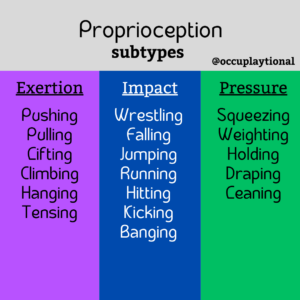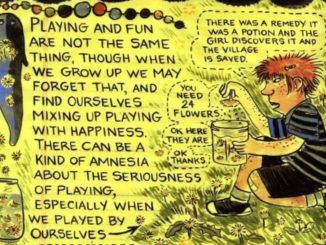When I try to define the word “proprioception” I usually refer to it as “deep body sense”. The sensing part of it also has to do with your sense of body in space and your body in relation to itself and other objects. Proprioception is sometimes called the “universal regulator” in that nearly everybody in the world finds proprioceptive input to be regulating to their body in some way.
Proprioceptive sensory input is sometimes called “heavy work”. Because of its role as the universal regulator, it is described throughout sensory-informed websites, images, etc as a good tool to utilize with almost all kids (and humans in general), regardless of whether you know their sensory profile or not. With kids who are sensory-seeking, proprioceptive input is likely to meet their active, seeking needs for high sensory input. For kids who are sensory-avoidant or sensory-sensitive, proprioceptive input may help their body stay settled and regulated even when other overwhelming input is present. For kids who are sensory-missing, proprioceptive input may help raise their baseline awareness of what’s going on in their body, or even if it doesn’t raise their awareness, it might help keep their body regulated and open up space for attention to other things.
This next part is out of my own describing and classifying, not taken from a different source, so I make no claims that it’s definitive or exhaustive. It’s very possible that I might’ve forgotten something. But as best as I can describe it, I think that proprioception —proprioceptive sensory input — can be subdivided into three types: exertion, impact, and pressure.

You can take these verbs and plug them into different environments to figure out what would fit. How do you push safely at home? Maybe pushing a vacuum cleaner, pushing against the wall to do wall push-ups, or scooting heavy things around to build a fort (couch cushions, mats, mattresses, heavy comforters/blankets)…? How do you lift safely at school? Carry books, put away chairs, carry something on an errand to another teacher or to the office, carry around a backpack, be the “door helper” and hold the door open…?
🟦Impact would be like wrestling, falling, jumping, running, hitting, kicking, banging.
Again, you can take these and plug them into a setting to try to figure out the best way to meet those needs. Maybe you can’t wrestle at school and you can’t hit or kick people, but you can certainly kick a ball or jump (which is “hitting” your feet against the ground!) Impact-seeking proprioception tends to alarm adults, or they want to tone it down somehow, but putting it into its own category helps us see how for example, pushing or lifting something may not actually satisfy a need for impact-proprioception, but maybe jumping or running would.
🟩Pressure would be like squeezing, leaning, draping, weight, holding or keeping something on or in that body part to “wake” it.
Pressure may be a little harder to intuitively understand if you haven’t spent much time in the OT/sensory-informed world, so some examples of it might be:
-wearing a weighted vest
-wearing a squeeze/spandex vest
-using a weighted blanket
-using a spandex/squeeze sheet
-wearing a heavy coat even when it’s not cold
-keeping an object held in your hand in order to “wake it up”
-wanting to wear shoes all of the time
-getting a tight squeezy hug
-rolling up in blankets
-burying self in cushions
The most societally acceptable seeking of pressure-proprioception is usually to seek out a hug. I know many kids who try to continue to wear heavy coats or hoodies if they aren’t made to take them off, because the weight feels soothing to their body. Carrying around a heavy backpack or purse can also be this way.
Again, this is fully only coming from my observed experience and thoughts and no source material or studies, but in that limited experience, I’ve observed different types of proprioceptive input being the primary type of regulator for different forms or root emotional causes of dysregulation.
I think that exertion tends to be the go-to proprioceptive subtype for when many humans are fearfully or angrily dysregulated. Impact (and exertion) tends to be the go-to subtype for when many humans are silly-dysregulated. Impact (and pressure) is sometimes the subtype that people choose when they are in pain or physical distress. Pressure tends to be the go-to subtype for when many humans are sad dysregulated.
These are not universal, because everyone is different and may reach for different things, but this is a pattern I’ve observed in my own life, children, and practice.
People with substantial sensory processing differences may experience extremes, or show “deficits” in one of these areas. For example, kids may struggle to gauge how much pressure is the right amount to write with a pencil, and snap the pencil — or conversely, write in such faint writing you can barely read it. Or how much pressure is the right amount to push in a chair, and slam it in. They may struggle with gauging the right amount of impact for things and hit too hard, hug like a tackle, or wrestle too rough when they try to do these things. They may have difficulties with over- or under-exertion, either filling up too fast on the sensory input and having no energy left for things or needing an endless amount of it to feel right in their body.
Why is it worth writing all this kind of information out like this? I believe that having language to describe what it is that we’re seeing (or personally experiencing) helps us make sense of it. If you can put more specific words to what is happening with a child than just “he’s bouncing off the walls” or “she’s being wild and rowdy” then it helps you see what it is that is actually happening. He’s seeking regulation via proprioceptive input and he’s tending towards seeking out impacts. She’s using proprioception to regulate herself and she’s tending toward exertion. Those are harder statements to parse if you don’t know what they mean, but if you do, they’re much more actionable.



